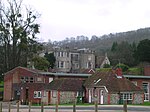Duncton to Bignor Escarpment
Sites of Special Scientific Interest in West Sussex

Duncton to Bignor Escarpment is a 229-hectare (570-acre) biological Site of Special Scientific Interest west of Pulborough in West Sussex. It is a Special Area of Conservation and Bignor Hill is a Nature Conservation Review site, Grade I.
Excerpt from the Wikipedia article Duncton to Bignor Escarpment (License: CC BY-SA 3.0, Authors, Images).Duncton to Bignor Escarpment
Glatting Lane, Chichester Sutton
Geographical coordinates (GPS) Address Nearby Places Show on map
Geographical coordinates (GPS)
| Latitude | Longitude |
|---|---|
| N 50.92 ° | E -0.62 ° |
Address
Glatting Lane
Glatting Lane
RH20 1PR Chichester, Sutton
England, United Kingdom
Open on Google Maps










